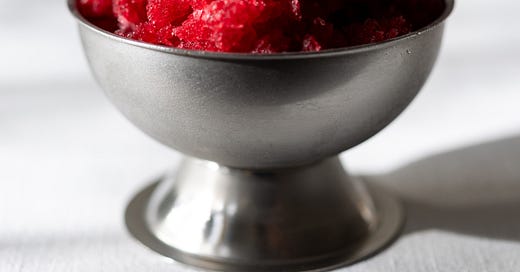A granita looks and feels like icy snow, it is beautifully coloured like glittering sequins […]
– Nadia Roden
It’s usually a Sunday in early to mid March when Brandon dons his Brandana and heads outside with a wooden board, sieves, and a paring knife, to process the pomegranates from our tree – our curtains still bear the stains of a juice bath from the first year, when we did it in the kitchen.
The fruit hangs heavy on the branches, some have fallen to the ground or split open to reveal their seeds, and we avert our eyes because we know we should have attended to them in February already.
The reason for all this effort is he’s not a fan of unavoidable pips – think granadillas, guavas, and pomegranates. And, since he’s been juicing the pomegranates, I’ve come around to his way of thinking: jewel-like arils are pretty, but I prefer pure juice.
March is also Brandon’s birthday, which marks the last true summer’s day and a spike in degrees Celsius before we settle into autumn. So, his celebratory lunch inevitably finishes with pomegranate jelly or granita.
What I love about those two preparations is that it allows the hard-won juice to shine, without doing much more than changing its form. Adding a small amount of sweetness accentuates the sour, like salt turning up the flavour when seasoning something savoury.
When freshly pressed, drinking the acutely tart, ever-so-slightly tannic pomegranate juice feels like administering a tonic. And that’s what makes it perfect for granita. Whatever the flavour, it needs to be highly concentrated.
Usually the kilograms of pomegranates yield one to two cups of clear, ‘free run’ juice and freshly pressed pomegranate juice is sold at certain markets too. Almost more important than the choice of flavour is the key takeaway about flavour: intensity.
Fresh pomegranate juice also freezes really well, so 250ml tubs of the juice are stacked in the freezer to be defrosted when looking to make refreshing dessert that will follow a hearty autumn or winter main.
Pomegranate granita
Add to a small saucepan 70g (about a third cup) of caster sugar and 60ml (a quarter cup) of water, bring to a boil and cook, swirling the saucepan now and then, until the sugar has dissolved. Simmer for another minute or two. Remove from the heat. This yields around 60ml (a quarter cup) of syrup, which is just right for 500ml pomegranate juice that sits on the sour end of the flavour spectrum.
How much syrup you add will depend the juice. Add the syrup tablespoon by tablespoon, tasting after each addition, so it’s the right balance. Add just enough syrup to temper but highlight the sour, rather than making it totally sweet. For us it depends on whether the juice comes from our tree, which has astringent seeds the colour of garnets, or our neighbour’s tree, which offers ruby-red seeds that taste as sweet as a lolly. Refrigerate any remaining simple syrup in a jar to use when making cocktails (Brandon also loves an Old Fashioned).
Pour into a stainless-steel tray or baking tin, cover and freeze for one to one and a half hours or until it is frozen in parts but not completely. Scrape with a fork to fluff it up and then return to the freezer until fully frozen. Just before serving, scrape with a fork to fluff it up again and serve immediately in pre-chilled glasses or stainless steel ice-cream cups.
I use a rectangular glass dish with a clip-on lid because it fits neatly in the freezer but freezing does take a little longer. As long as the size of the tray or container creates a fairly shallow layer of liquid. It also helps to do this in a clear freezer as the freezing will naturally take longer if the shelves are overloaded.
Granitas are best eaten on the day they’re made. As a young food stylist (probably around the time I planted the pomegranate sapling), I remember reading a description by Nadia Roden, who authored a book called Granita Magic1: ‘A granita looks and feels like icy snow, it is beautifully coloured like glittering sequins […]’ This quality starts fading from the moment it is served so urge everyone to eat their granita pronto!
Updated and edited on 29 June 2024.
Granita Magic by Nadia Roden (New York: Artisan, 2003)





